Check out the latest ExxonMobil earnings call transcript.
In March of last year, oil giant ExxonMobil (XOM -0.84%) unveiled a bold investment plan that will see the company spend billions of dollars to expand its integrated energy business in the coming years. This investment spree puts the company on track to double earnings and cash flow by 2025 with no improvement in oil prices. Underpinning the company's strategy will be investments to expand its upstream oil and gas production out of the Permian Basin as well as its downstream refining and chemical businesses along the U.S. Gulf Coast.
Exxon took an important step toward executing its plan this week by giving the green light to two key projects that will enable it to maximize the value of its Permian production. In doing so, Exxon has increased the likelihood that it can deliver on the promises of its ambitious expansion plan.

Image source: Getty Images.
Getting out ahead this time
ExxonMobil and its partners, Plains All American Pipeline (PAA -1.86%) and privately held Lotus Midstream, formally agreed to move forward with construction of the Wink to Webster Pipeline. Plains All American will take the lead in building the 650-mile pipeline that will move oil from hubs in the Permian to the Houston area, where it can flow into the region's refineries, including Exxon's facility in Beaumont. The pipeline will have the capacity to transport 1 million barrels of oil per day (BPD) and should start service in the first half of 2021.
Pipeline capacity has become a problem in the Permian over the past year as producers grew production faster than infrastructure developers could keep up. Because of that, Plains All American and others have been building pipelines as quickly as they can. Plains All American finished one project late last year and should start full service on another by April of 2020, while several other pipelines should start up in the late 2019 to mid-2020 timeframe. Those projects will enable regional producers to restart their Permian growth engines later this year and should provide adequate takeaway capacity for the foreseeable future.
Exxon wants to ensure nothing derails its long-term strategy. That's why it has worked with Plains All American to spearhead this new pipeline -- to ensure it has a way to move its oil out of the Permian in the coming years. By moving forward with this pipeline, Exxon will have the oil takeaway capacity it needs to support its plan to boost output from the region five-fold by 2025 to as much as 800,000 barrels of oil equivalent per day (BOE/D).

Image source: Getty Images.
A big boost to capacity
Exxon also made a final investment decision this week to begin construction of a new unit at its refinery in Beaumont, Texas. The project will increase that facility's capacity by 250,000 BPD, or 65%, bringing it up to 616,000 BPD and making it the largest such facility in the country, slightly bigger than the 603,000 BPD Motiva plant owned by Saudi Aramco. The company aims to complete this expansion by 2022.
Exxon is building this additional refining capacity so it can process more of the oil it produces out of the Permian Basin. This investment will enable the company to make more money on this output by refining the crude oil into higher-valued products such as gasoline and diesel, which it can sell on the domestic market or export globally. That ability to maximize the per-barrel profits of its production is one of the many reasons Exxon believes its investment strategy can double its earnings and cash flow by 2025 without any improvement in oil prices.
An end-to-end solution
ExxonMobil is sitting on a gold mine of low-cost oil in the Permian Basin. While the company can make a significant amount of money pumping more of that crude out in the coming years, it can make even more by leveraging its integrated operations to not only invest in a new pipeline to ship that oil to the coast, but increase its capacity to refine this oil. Those investments, along with others it's making around the world, position the company to produce a gusher of profits over the coming years, even if oil prices stagnate, which is an opportunity investors won't want to overlook.





